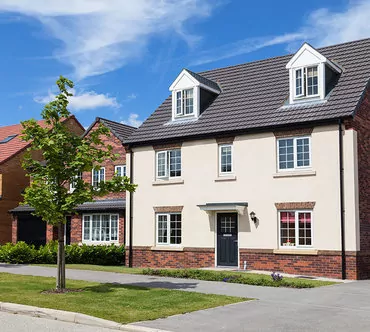Help to Buy Scheme
Banner Jones can offer help and guidance on the Help to Buy Scheme.
Help to Buy Scheme in Chesterfield, Sheffield, Dronfield and Mansfield
The new Government help to buy scheme was introduced in April 2013 to help stimulate the housing market by providing loans of up to 20% of the purchase price on a new build home. We know that saving for an adequate deposit can be very hard for first time buyers in the current market so the loan will help to bridge the gap between what you can borrow from a mortgage lender and what you can afford as a deposit.
Key facts on the Help to Buy Scheme
- The loans are available on new build properties only
- It is open to both first time buyers and people who have a property to sell
- It must be the person’s main residence. It cannot be a sublet or be a second home
- You cannot keep your existing property and let it out
- You must take out the standard first mortgage with a qualifying lender
- There is no higher income threshold
- The maximum purchase price is £600,000
- The loan will be repaid on the sale of the property or after 25 years, whichever comes first. You can also make voluntary repayments
The Help to Buy Scheme Process Explained
Homebuyers can now consider whether to take advantage of the second phase of the Government's Help to Buy scheme, brought in three months early in a bid to help revive the property market.
Phase 2 is available to existing home-owners looking to move to any type of property, not just first-time buyers. The buyer must still put up at least a 5 per cent cash deposit, but the Government no longer lends actual cash to the buyer. Instead, it guarantees up to 15 per cent of the mortgage granted so that, if the borrower defaults and the property is repossessed and sold for less than the balance of the mortgage, the lender can apply directly to the Government for repayment under the guarantee.
The buyer needs to contribute a cash deposit of 5 per cent of the purchase price, and to satisfy the lender's usual checks. The aim is to reduce the risk to lenders so that they can offer cheaper interest rates to buyers. The lender pays the Government a fee for its guarantee.
The property must be worth less than £600,000, and borrowers must not own any buy-to-let properties or intend to keep the home they currently live in after the purchase.
Help to Buy Home Scheme Example
In an example where you purchase a £200,000 home under the help to buy scheme, the agency’s contribution of the equity loan totals £40,000 or 20% of the purchase price. You will be required to produce a 5% deposit of £10,000 and a mortgage of £150,000.
The equity loan is interest free for the first 5 years. After 5 years you pay a fee of 1.75% rising annually by the increase in the retail price index plus 1%. In year 6 on the previous example of £40,000 this would be approximately £58 a month.
How to Buy a Help to Buy Home
Stage 1 - Application
An application needs to be made to the local help to buy agent. The application includes a Property Information Form which shows details of the proposed purchase, main mortgage, deposit and household income. The Property Information Form also confirms your agreement to the funds due being paid directly to the house builder.
You will need to sign the Property Information Form with a copy of the Builders Reservation Form which must be sent to the local home buyer agent.
Authority to proceed
The local home buyer agent assesses the application and if passed they will issue an authority to proceed. This is valid for 3 months and exchange of contracts must take place within this period.
Stage 2 - Exchange of Contracts
You will need to go through the normal conveyancing process with regard to the property but you will also need legal support with the signing of the help to buy equity loan agreement. Banner Jones can help you with this.
We will need to check that the mortgage offer, property price and available funds are consistent with the authority to proceed and request permission to exchange contracts from the local home buyer agents.
An approval is received before contracts can be exchanged.
Stage 3 - Completion
- The agents pay the funds direct to the developer.
- We return confirmation of the sale to the local home buyer agent who will then register the details with the post sale home buyer agent.
- We deal with the registration of the second charge. ie, the loan
Sale of the Property
Consent from the post sale home buyer agent is required and the agencies mortgage will only be released with their permission. Their main concern is that the sale of the property is at the correct market value and they can request an independent valuation to ensure this.
Want to know more?
Common Help to Buy Scheme Questions
You can withdraw from a sale or purchase up until the point contracts have been exchanged. Any deposits paid after exchange of contract will then by non-refundable. After contracts are exchanged you are then responsible for the property you are buying and should arrange suitable insurance from this date. A local authority search completed for a house purchase is valid for 3 months. We usually say 8-12 weeks for an average sale or purchase. Queries and concerns can often come out of the local authority searches which need further investigation and sometimes this leads to re-approval from the Mortgage lender. This can add further time into the process. You can indemnify the work by taking out an insurance policy. This means that you can not be held liable for any future fault on the work that was done. We can arrange this for you Stamp Duty is a tax levied by HM Government on a transfer of property. For residential single property ownership this tax is calculated at 5% for the portion of the property value between £250,001 and £925,000, 10% for the portion between £925,001 and £1,500,000 and 12% for the portion £1,500,001 and over. Duty may also be chargeable on any rental charge (leases only) - this affects both residential and commercial leases where different thresholds are applied. There are different rates for First time buyers and "second homes/buy to let". Tenants is Common is where two or more people are entitled to the proceeds of sale in distinct shares - on the death of one, his/her interest will not pass to the survivor(s) but will be part of his/her estate. Joint Tenants are on the other hand 50/50 Co-owners of land - when one of them dies, his/her rights of ownership pass to the survivor(s).
At what point in the process is it legally binding?
How long are local searches valid for?
How long does the conveyancing process take on average?
What happens if we can’t produce certificates for work we’ve had done on the house we’re selling?
What is Stamp Duty and how much will I have to pay?
What is the difference between Joint Tenants and Tenants in Common?
We take data privacy very seriously, and we want you to understand and feel confident about how we collect, store and handle your personal data. If you’d like to find out more you can read our Privacy Policy.






















